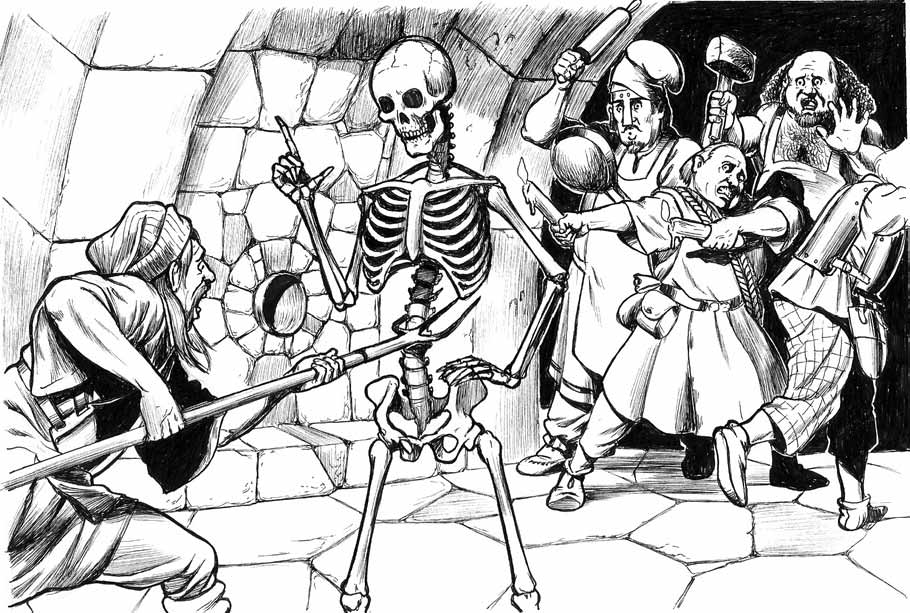I am having a really hard time explaining people what I do when I run games. It is the next section I am trying to work on for FLoK, but even with the help of some folks who I have run games for, it is slow going.
To help the process along, I figured I would make some qualitative systems that sort of line up with how I tend to do things at the table. Mind you, this isn't what I actually consciously have in the back of my head while running, but I think using this will land you in a similar place.
To help understand where I am coming from it might be useful to keep in mind what my number one principle is when running games: Fluff = Crunch. Both for players, as well as for GMs.
With that out of the way, here's some systems:

Harm:
Scuffs and Bruises
These take a toll on you, making you less effective overall, but don't prevent you from doing anything. They heal quickly and rarely cause lasting problems.
Severe Wounds
These are severely impairing wounds, like broken bones, concussed heads and deep cuts, preventing you from performing certain tasks and rendering you almost helpless when in danger. They require time to heal and if not taken care of correctly will lead to lasting problems.
Lethal Injury
These are spilled guts, shattered spines and fractured skulls, will kill you if left untreated and render you completely useless until healed. They take a long time to recover from and almost always cause lasting problems.
These are not a covert way of doing hits. You could suffer from multiple severe wounds without any lethal injury and scuffs and bruises might indirectly cause you to suffer severe wounds because you function less well, but only in very rare cases become so severe they would graduate to a severe wound. Just do what would make sense in the fiction.

Encumbrance:
Fighting fit
No wounds, non-fatigued and carrying little more than arms and armour or something equivalent.
Trudging along
Scuffed and bruised, fatigued or carrying an impairing burden such as a heavy backpack.
Staggering
Severely wounded, exhausted or carrying something you can barely hold such as a heavy boulder or a large, oddly-shaped box.
In a dire situation, someone trudging along finds it hard to react, while someone who is staggering is completely helpless. These are meant as a tool to make keeping track of encumbrance easier, don't get too hung up on the categories and trust your gut.
Closing thoughts:
Harm is something I always just run diegetically, but it turns out some folks find that difficult. I primarily think about harm in terms of consequences and base this on my experience with martial arts. To me, that is also the main differentiator between these three levels of harm: how does this change what a PC can do?
Encumbrance is something I don't often adress. My games are either too short for it to matter, or the group I run for is too big for me to want to keep track of it. Slots seem like a good alternative, but everytime I use it, it ends up being quite a lot of work and eats up too much time at the table. With this I hope to have a way of doing encumbrance that is easy enough to understand that players can do it themselves, without the minutiae of keeping track of individual slots. As you might be able to tell, it is definitely inspired by slotbased encumbrance, as stuff like injuries and exhaustion affect encumbrance much like they often do in those systems.
As
I am falling further and further down the FKR hole, I find myself not
really wanting stuff like HP or hits (which seems like they are exactly
the same as HP to me, but that could just be my ignorance) but first try
to look at in-universe logic to see what makes sense (inspired by less rules to do more).
Same for encumbrance slots: though they are a piece of elegant design
that can be used in many different and interesting ways, they have too
many edge cases which feel cumbersome for my playstyle (I run most of my
games for students aged 12 to 16), whereas the bulky item rule from
Electric Bastionland seems like it is a bit too streamlined. However, I cannot be the only one moving away from HP, Hits and Slots and I'd love to know what other ways people have found to deal with those aspects of adventure games.
I have been using qualitative levels of harm in the FKR Palaeolithic voyaging I've been running for the last couple of months. The levels of harm I give out are really just conditions in the Torchbearer sense, no different in notation than, say, fatigued or hungry and thirsty. Encumbered could readily be used in the same way.
ReplyDeleteAs for wounds, I use bruised, hurt, wounded. A couple of each normally add up to the level above; a couple of wounds and you're dead. Of course characters with unusual qualitative levels of toughness would soak up more damage.